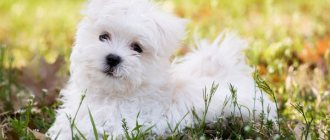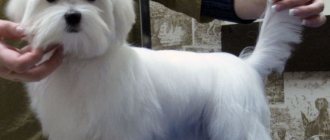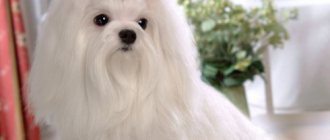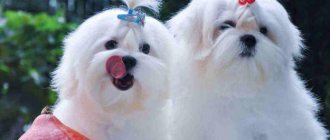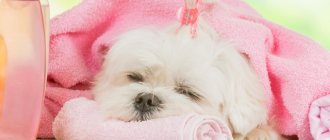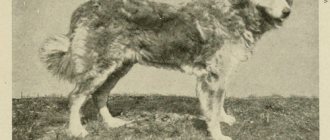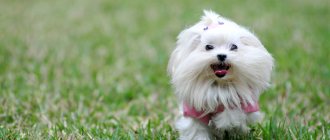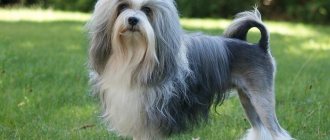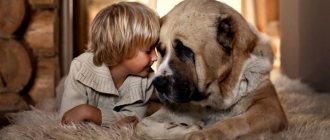Origin story
The lapdog breed could only arise in an era of prosperity and luxury: lapdogs are not capable of hunting, fighting, or guarding. These dogs are of little use. However, images of dogs very similar to lap dogs have been found in ancient Egyptian sources.
While depicting lapdogs, the predecessors of modern breeders did not bother to leave records on the breeding of indoor dogs. No wonder: who could be interested in a useless dog that pleases the eyes of representatives of the highest nobility?
They tried to attach the lapdog to the business. Repeatedly they were assigned to hunt rodents - on ships, in palaces. But the result was not impressive. Each time there were breeds that were more successful in this field.
In the Middle Ages, European aristocrats gladly inhabited castles and palaces with playful, cheerful lap dogs - a kind of indicator of wealth and luxury, indicating the refined taste of the owner or owner.
The name of the breed itself comes from the Italian city of Bologna, although, with the same success, lap dogs could be named after any other European city - the European aristocracy was surprisingly unanimous in their enthusiasm for buying dogs of this breed.
For centuries, breeders have tried to make the appearance of the representatives of the breed as touching as possible, and their character as playful and loving. Judging by the number of varieties of lapdogs and their continued popularity throughout the world, this problem has been completely solved.
Many world-famous stars have kept or are keeping lap dogs as permanent companions. You can mention Patricia Kaas, Elvis Presley, Elizabeth Taylor, Cindy Crawford and even Barack Obama . Among domestic famous people, the lapdog was seen in Alla Pugacheva .
Education and training
Raising these little ones is not easy if you like to raise your voice over trifles. The aristocratic nature of the Maltese does not tolerate swearing, screaming and (scary to think) beating.
Like any aristocrat, the Maltese easily falls into hysterics and despair, and will demonstrate the full “I’m offended” package, including completely ignoring the offender and even depression. You won’t be able to “outshout” your pet - energetic, lively kids can bark for hours, driving their owners into despair and their neighbors into a rage.
Hence the conclusion: the Maltese needs to be treated like a child. Be kind and friendly, then raising Maltese dogs will not cause many problems.
Why train such a baby, we took her to love and bask next to her? In six months or a year, such owners will change their minds about training and education: the dog will bite them, do whatever he wants, and he doesn’t care about all the owners. Any dog needs to be trained, from tiny little ones to motorcycle-sized giants. The dog must know the owner of the pack and obey him. This is an immutable law.
Gentlemen and lady
Maltese will be eager to learn through play. But don’t think that they pick up commands on the fly. Maltese dogs, although loyal to their owners, are not very smart and diligent in their studies. These pets can master the command after 10-20 repetitions. There are dogs that learn a command in 5-6 demonstrations and repetitions - this is for reference.
In the game, Maltese can be taught to stand on their hind legs, do a “bunny”, spin around and other tricks. Praise the little ones more often for correctly executed commands and reward them with treats. Lapdogs are very responsive to affection and kind attitude, to the love of their owner.
Description and characteristics of the lap dog
The lapdog is a small dog, its height is from 20 to 35 centimeters, and its weight is from 2.5 to 5.2 kilograms.
- Round head and square muzzle with dark, shiny eyes.
- The nose and the edges around the lips are black.
- The bite is pincer-like.
- The neck is of medium length, without folds.
- The back is straight, the chest is voluminous.
- Paws – without developed muscles, but with strong bones. The pads and claws are black.
- The coat is long and its type varies depending on the type of dog.
- Color is mainly white. In some varieties, pale orange coat color and ivory are allowed.
Rules of care and maintenance
Care does not require much effort if there is no desire to participate in exhibitions. The coat should be clean and free of tangles; to do this, brush the dog daily.
Puffers are harmful to the skin. Use dog combs for combing and untangle the strands with your hands. You can cut it short, leaving some length on the head, paws and tail, this will make it easier to care for. Wool takes a long time to grow, so you shouldn’t get carried away with it.
It is necessary to trim the anus and paw pads. Hair gets tangled more often in these places. There is no need to cut your head. To keep them out of the way and out of your eyes, secure with an elastic band. Groomers will give your pet a haircut according to the rules.
Wash once a week and wash paws after every walk. After washing, dry with a soft towel and dry with warm air from a hairdryer. Use shampoos and conditioners to wash.
You can trim the nails yourself or go to a veterinary clinic. Once every two weeks, cut and file them. This is easier to do after washing.
It is advisable to wear the lap dog's hair in a ponytail.
Hair and dirt getting into your eyes can cause inflammation, so keep your hair in a ponytail. Keep your ears clean too.
All animals are prone to tartar formation. Therefore, brush your teeth at least three times a week. Neglecting oral hygiene will lead to gum inflammation and tooth loss.
Use soft brushes for small children. Toothpaste for dogs. You need to get used to the procedure from a young age and gradually.
Character traits
The lapdog is a unique dog, capable of being in a great mood around the clock.
A sea of energy, inexhaustible curiosity, adoration of the owner and household members, constant readiness to play and have fun - the explosive temperament of the lapdog cannot tolerate loneliness and inaction. But the cute white creature also has a “dark side”: the lapdog’s extreme jealousy can seriously ruin the owner’s life. If on neutral territory a lap dog sees its four-legged “colleagues” as an excellent company for games, then on its own it will try to ruin their life as much as possible. An owner who strokes another pet is a real tragedy for a jealous lap dog. There is nothing for other animals to do in the house.
Lapdogs also have a negative attitude towards strangers coming into the house. If it concerns a pizza delivery person, a signature collector or a postman, it’s not so scary, but the reaction will be the same for relatives and friends. The frantic barking of a dog will warn the owner about the approach of unwanted guests, and they themselves will bark in full force. If the lap dog felt that the visit had taken the owner’s attention away from it, the standard dirty tricks of a small dog are possible: chewed clothes or an unscented puddle in the shoes.
Leaving representatives of the breed alone for more than an hour is strictly contraindicated. A sad, unhappy dog will very quickly realize that it has definitely been abandoned, will become upset and will begin to actively take out its stressful state on the furnishings of the apartment. Wires, decorative items and furniture, things will suddenly become chewed, piles and puddles will form on the floor by themselves, but the lapdog will greet the stunned owner with genuine joy.
Children love playful and cheerful lap dogs. The dogs respond to them in full reciprocity - until the moment when the contact becomes too close. Run and play - yes. Scratching is also welcome, but a tight hug is no longer the right thing: the lapdog will try to get out of sight as quickly as possible.
Let's supplement the description with frequent ringing barks, which bring true pleasure to the neighbors, and we will get an ideal companion dog, from the point of view of medieval breeders.
Description, varieties and breed standard
There is no single breed standard for Maltese dogs in the world. There is the FCI standard, which is followed in Russia, the standard of the British Kennel Club and the US Kennel Club.
Cheerful and sweet friend
Characteristics that, according to the FCI standard, a white Maltese dog must have:
- Wool is beauty and pride. Soft, silky to the touch, straight, ideally falls to the floor. Straight, without curls or waves.
- Coat color (color) : snow-white, a light shade of ivory is allowed. Thin, light, very pale shades of orange are acceptable (but not desirable).
- The eyes are round, rather large, and black.
- The edges of the eyelids, lips, and paw pads are pure black.
- The nose is black.
- bite .
- the body is one third greater than the height at the withers.
- The height at the withers for males is from 21 to 25 cm, for females from 20 to 23 cm.
- Weight from 2.9 to 4 kg.
- The tail is curved, thin towards the end, thickened at the base; curved to the side. Completely covered with thick, long hair falling down.
Many people have heard or read somewhere about the mini Maltese. That they are exactly like regular Maltese dogs, only half the size.
A mini Maltese can (with a stretch) be called a Maltese, for which there is a standard from the American Kennel Club (AKC). It states the maximum weight of a dog is 3.18 kg. Preferred weight is 1.82-2.72 kg.
Accordingly, with the correct body proportions, the animal’s height will be less. But these are not dwarf lapdogs, nor weak, small puppies. It’s just that in America there is a demand for mini-sized Maltese dogs, and demand is generated not only by supply, but also by breed standards.
Breed standard
The difference in the FCI and AKC standard for Maltese is small (both dogs will be called Maltese or Maltese, without any mini or micro): in weight it is quite significant, in color - AKC allows pale lemon and pale red-brown spots on the ears.
According to the FCI standard, the bite is full, scissor-shaped, while the AKC standard is scissor-shaped or straight. These are the main differences. But if you want to show off your mini Maltese at an exhibition, you will be disappointed. In Russia, as already mentioned, the FCI standard has been adopted, and a baby weighing one and a half kilograms will not pass the standard. But you won’t love her less because of this, will you?
Types of lap dogs
Stopping in time is not about those creative people who were breeding lap dogs. There is always an opportunity to improve the achieved result. Currently, as many as 8 varieties of lapdogs are known. Briefly about each type.
Coton de Tulear
This lapdog is the result of crossing an Italian lapdog and a French bichon. They bred this dog breed in Madagascar, which is also considered the birthplace of the Coton de Tulear. These dogs were in demand on merchant ships - they were very successful in hunting small rodents. On the same ships, Madagascar lap dogs reached Europe. The first Coton de Tulear appeared in France at the end of the 19th century. A few years later, this type of lapdog reached the New World. In Russia it is still considered an extremely rare breed.
The Coton de Tulear received recognition from the Fédération Cynologique Internationale in 1970.
- According to the standard, these lap dogs grow up to 32 centimeters and weigh from 6.5 to 7 kilograms. Squat dogs with an elongated body, short, strong legs.
- The eyes are dark brown in color, the ears hang down to the cheeks, and are set quite high.
- Silky white coat up to 9 centimeters long. Can be straight or wavy.
- The color of purebred Coton de Tulear is pure white. But individuals with small fawn markings are also allowed to breed.
Maltese dog
Maltese are considered the oldest lapdogs. According to numerous statements by researchers, it was this variety that decorated the homes of noble ancient Egyptians. The development history is unclear. Relatives of the Maltese include Tibetan terriers, Alpine Spitz, and poodles. Not a single version has been proven. France and Italy became the second and third homelands for the Maltese in the Middle Ages. European aristocrats bred these dogs with manic persistence, proving to each other their subtlety of taste. Maltese dogs appeared in Britain only in the 16th century; they reached the New World even later.
There is also the usual uncertainty with Maltese standards. In most of Europe, including Russia, the Fédération Cynologique Internationale standard is recognized.
The UK is guided by the documents of the United Kingdom Kennel (KC), and the USA has traditionally created its standard under the auspices of the Kennel Club (AKC). It must be said that the American version of the Maltese is lighter - up to 2.7 kilograms , the coat is shorter, and the muzzle is much narrower than the international standard.
- According to the FCI standard, Maltese grow up to 20-25 centimeters and weigh 3-4 kilograms.
- Large nose, eyes – dark ocher color, with black edging.
- The ears are triangular, hanging, wide, set high, covered with thick, long hair.
- The neck is approximately the same length as the head. The stomach is tucked. The paws are round in shape, with black pads and fur between them.
- The tail is curved, touches the back, and is covered with soft hair.
- The coat is straight, hanging, silky and dense. Length – about 20 centimeters. No tufts, tufts, or fringes.
- Color – white, possible ivory shade.
Dwarf Maltese
Brown or mini Maltese differ from standard Maltese dogs only in size and shortened muzzle, which gives the tiny dogs a “childish” appearance. The weight of such lap dogs is from 1.5 to 2.5 kilograms. They do not meet the breed standard, but fans of the “mi-mi-mi” take apart the Mini Maltese in flight. Dwarf Maltese are born to both European and American versions of the Maltese, but the “American” ones are more common.
Small Lion Dog, Lewchen, Bichon Lyon
The most controversial variety of lapdogs, most likely, has nothing in common with bichons, but is listed in this section as a decorative species. Researchers believe that bicolor lap dogs appeared as a result of crossing Epagnols and Great Danes as early as the 2nd century AD . Such lap dogs were not in particular demand, and in 1960 they were included in the Guinness Book of Records as the rarest breed of dog. Impressed by this fact, the Fédération Cynologique Internationale recognized the Bichon Lyon in 1961.
According to the standard, these are quite large dogs for lap dogs - up to 32 centimeters tall.
With long, fluffy fur and several color variations: black, brown, piebald, gray, red with white stripes.
To live up to their proud name, small lion dogs are cut “like a lion” : the hair on the body and hind legs is removed, leaving feathering on the head, neck, sternum and tip of the tail. Work on this variety is still underway; breeders are looking for and breeding dogs with a square skull and body - this is a distinctive feature of the Bichon Lyons.
Bichon Frize
In the 13th and 14th centuries, ship crews visiting the Canary Islands were surprised to find small white dogs in the tropics and took the trusting kids with them. Along the way, the animals destroyed the population of rats and mice. Impressed, the sailors kept most of the dogs for themselves, and sold the smaller part to European traders.
Dogs from the Canary Islands attracted both aristocrats and circus performers. In Spain, France, Britain and Italy, Bichon Frize found their fans and competent breeders who actively improved the breed. As a result, the standard states that the Bichon Frize is a French breed.
Translated from French, “frise” means “curly.” This refers to the description of the snow-white coat of the French Canarian lapdog. The curly, springy coat reaches 10 centimeters in length. The lap dog's dimensions also did not disappoint: height - up to 30 centimeters, weight - about 5 kilograms. The color is white, although puppies have red markings that disappear with age.
Russian Tsvetnaya lap dog
As the name suggests, the breed was bred in Russia, in the hero city of Leningrad. Among the ancestors of the colored lapdog are poodles, Lhaso Apso and Shih Tzu. Breeders sought recognition for quite a long time, and in the 1960s the Soviet Cynological Association recognized the breed. At the international level, this variety is still not recognized, but breeders are making great efforts in negotiations with the FCI.
The main difference between Russian lap dogs is color. They can be black, all shades of brown, gray. White spots are not acceptable. Height – up to 24 centimeters, weight – does not exceed 4 kilograms. In appearance, he is a typical Bichon with floppy ears, a short muzzle and a bushy tail.
Possessing all the features of a lapdog, the Russian Colored is ready to tear anyone apart if that someone threatens its owner. The 20-centimeter guard dog looks funny, but it all depends on the place to which the lapdog jumps.
Havanese Bichon
The Havanese Bichon is originally from Cuba. He inherited the characteristic national traits of the good-natured Cubans: a craving for comfort and amazing friendliness towards people and animals, which distinguishes him from other lap dogs.
It is believed that the Havanese Bichon, or Havanese, appeared as a result of active crossing of lapdogs, poodles and Cuban yard dogs. The first individuals were born in the 18th century, and international recognition was received in 1996.
Hot Cuban mongrels added brown and black spots to white lapdogs. The height of “Cubans”: up to 25 centimeters. The body is rectangular, with pronounced withers. The muzzle is short, the skull is rounded, the ears hang down. Everything is like a decent lap dog.
Bolognese, French (Italian) lap dog
The French lapdog is actually Italian, originally from Bologna. The most authentic Italian lap dog. But Russia has its own attitude towards foreign words, especially during the reign of Catherine II, who, in fact, was given cute dogs.
This type of lapdog has been known since the 12th century, when they became regulars on Italian estates.
The difference between this variety is its loose, wavy or curly coat, covered with curls. This coat gives the dog the shape of a ball, although their figure is fit and graceful. The only possible color is white, without spots.
Bolognese grows up to 30 centimeters.
Japanese lap dog
Sometimes the Japanese Chin breed is called the Japanese lapdog due to the similarity in appearance and size. But this is still not a type of lapdog, but a separate breed.
Types of lap dogs
Now the lapdog breed is a whole group, which includes the Russian colored lapdog, Maltese lapdog, Havanese, French and so on.
In the photo there is a Russian colored lapdog
The Maltese dog is rightfully the most popular dog in the world. Archaeologists have found figurines of these lovely creatures in the tombs of Egyptian pharaohs dating back to the eighth century BC. Their homeland is still unknown for certain; China, the Philippines and, of course, Malta are fighting for this right.
Maltese are very energetic, affectionate dogs, they love to run and play, they are sensitive to the mood of their owners, and can also be offended. They have white silky fur, intelligent black eyes, black lips and nose.
In the photo there is a Maltese dog
A Maltese dog, which not everyone can buy, is a good friend who will always please and support.
Pictured is a Maltese dog
The Russian Tsvetnaya lapdog is a breed that was bred by Russian specialists. A kind of mini lap dog. A distinctive feature from other Bichons is that its color can be absolutely anything except white. The Russian lapdog, like its Maltese relative, is a decorative dog.
They have a very kind and sociable disposition, so she simply needs the love of her owners, their attention and care. You need to play, talk and play with them very often, otherwise the dog may get bored and begin to feel unnecessary
In the photo there is a Russian lap dog
The size of the Russian breed does not exceed 20-24 centimeters at the withers, has thick hair, it can be either curly or wavy. The color is always monochromatic. Thanks to years of selection, this lapdog has an ideal physique, health, and strong psyche.
The Havanese lapdog, a photo of which can be seen below, was brought to us from Cuba, where it most likely came to Spanish emigrants. Its second name is the “Havanese Silky” dog.
She, unlike other types of lapdogs, is not only a decorative dog, she is quite capable of performing guard duties, thanks to her innate qualities. Often used to protect livestock, sensing danger, the Havanese lapdog starts barking, from which it is not difficult to wake up.
Pictured is a Havanese dog.
In addition, dogs are very trainable, they make circus performers, and thanks to their playful disposition they perform excellent tricks. Compared to other lap dogs, the Havanese is quite square in shape, has strong paws and can jump high and runs quite fast. The height of the Havanese lapdog is from 20 to 28 centimeters, weight from three to three and a half kilograms.
She has a long head, the muzzle tapers towards the nose and is quite short. The eyes are large and shaped like almonds, the ears are drooping and set high on the head, the tail is curled into a ring. Their fur is wavy or has small curls. The color is most often brown, but can also be cream, golden, gray, blue, and most rarely black or white. May have spots.
The Bichon Frize is a small French dog. It can grow from fifteen to thirty centimeters in height and length. Dogs are always completely white, only lapdog puppies can have reddish or beige markings. Their fur is long and thick, very curly.
The photo shows a Bichon Frize dog.
In the 13th and 14th centuries, their ancestors were excellent rat catchers on ships. The breed is very cheerful and loves to play and likes to move a lot. The dogs are very brave, but do not show aggression. Walking in the fresh air is mandatory for him, otherwise health problems will arise.
The French lapdog is perhaps one of the largest bichons. They were bred in Italy by crossing Maltese dogs and miniature poodles, from which they got curly fur. In the sixteenth century, they gained popularity among royalty after they arrived in France. The correct name of the breed is Bolognese, which means dog from Bologna.
The coat color is usually completely white, but sometimes there are fawn markings on the ears. They are very cheerful and love to run and play. They grow quite large - up to thirty centimeters and seven kilograms. The tip of the nose is black, lips and eyelids too
These dogs are very attached to their owner, but are very careful around strangers.
In the photo there is a French lapdog
Features of care and maintenance
Of course, lap dogs are not intended to live on the street, and they have nothing special to do on a chain. These are dogs for home keeping. The place for the lap dog to sleep is warm, without drafts, away from the air conditioning and heating system. Ordinary bowls with non-slip bottoms are suitable for feeding.
Walk
Many varieties of lapdogs get along just fine without being walked at all, using a tray for “dog chores.”
For those species that require walks, their duration is not so important. It is advisable to walk an adult lap dog twice a day for 30-60 minutes - in the morning and in the evening. If you want to walk longer, don’t limit yourself. The dog will happily run after his beloved owner, practice acrobatic tricks, and overcome simple obstacles. In cold weather, you should not neglect warm overalls - lap dogs are very sensitive to low temperatures. And it’s better to reduce walking time.
Hygiene
As for grooming, you need to understand exactly whether the lapdog is taking part in exhibition events. If yes, then you cannot do without the services of a professional groomer: haircut, daily care, cosmetics, perfumes - nothing from this list will be superfluous.
It’s easier with a couch potato. Regular brushing - at least 3 times a week. No slicker brushes - they damage the delicate skin of decorative dogs. In order to make grooming easier, you can act radically and trim the lapdog, leaving hair only on the head, paws and tail. The coat and undercoat of this breed takes a long time to grow, and enough time passes between haircuts.
To avoid contact of the bangs with the eyes, they are collected in a ponytail and tightened with an elastic band.
- Water treatments – weekly, using shampoo and conditioner. After washing, use a soft towel or a gentle hairdryer setting.
- After bathing, it is advisable to pay attention to the claws. They need to be trimmed and filed.
- Brushing your teeth at least 3 times a week to avoid tartar. A pet brush and pet paste are used - with a pleasant smell and taste for the dog. It is better to accustom your lapdog to this procedure from early childhood.
- Ears need monthly cleaning. It is advisable to carry out examinations for inflammation, redness, and unpleasant odors several times a week.
- The eyes will have to be examined after each walk and, if necessary, wiped of discharge. A soft cloth or cotton pad with veterinary lotion will help. If redness, inflammation, excess discharge or tears appear, it is best to contact a veterinarian.
Feeding
When feeding lap dogs, it is recommended to use dry food of at least premium class - it contains all the vitamins and microelements necessary for the dog’s health. With a natural diet, you will have to add vitamin and mineral complexes to your food as prescribed by your veterinarian.
The natural diet includes the following products:
- chicken or beef meat;
- sea fish fillet;
- rice, buckwheat, oatmeal;
- boiled chicken eggs;
- seasonal vegetables and fruits;
- fermented milk products with low fat content.
It is strictly forbidden to feed a “terribly hungry” lapdog from your own table: she simply cannot afford most foods. In addition, you will have to exclude from the diet:
- marinades and canned food;
- smoked meats and sausages;
- spicy and with lots of seasonings;
- flour and sweet;
- river fish;
- chocolate.
Portion sizes need to be carefully monitored. On packages of dry food there are recommendations for the required amount, but with natural feeding it is better to draw up a menu with your veterinarian. An incorrect diet negatively affects the health of the lapdog, and the first sign is increased lacrimation.
Maintenance and care of a lapdog
If the owner does not intend to exhibit dogs at exhibitions and does not plan to participate in competitions, the lapdog does not require much effort and does not cause difficulties in caring for it. It is recommended to comb your pet daily, without using a slicker brush, so as not to damage the delicate skin by picking out tangles manually. To make caring for the dog's coat easier, you can cut your dog's hair. Due to the slow growth of fur, care will be greatly simplified. The area around the anus should be cut regularly, and the bangs should be tied with an elastic band so that they do not get into the eyes. To ensure that the haircut follows all the rules, provide the care of your pet to a highly qualified specialist, a dog groomer. Bathing procedures are carried out once a week using special shampoos and conditioners, but the limbs are washed after each walk, which is carried out twice a day for at least two hours.
In the cold season, lap dogs need to be walked in clothes. After bathing your pet, pat dry with a soft towel and dry with a hairdryer. Eyes and ears require care as they become dirty, but at least once every three days. Brushing your teeth is recommended every other day using a soft toothbrush. Nail trimming is carried out as needed. It is recommended to have up-to-date vaccinations appropriate for the dog's age. The muzzle is washed after every meal. Your pet's diet must include beef or chicken, cereals, eggs, fermented milk products, boneless fish, vegetables and fruits. If the owner is not able to calculate the required balance, it is better to buy ready-made dry food or alternate.
Do not overfeed this breed of dog, they are prone to obesity. Regarding nutrition, consult the breeder from whom you purchased your four-legged friend.
Like any other breed, lapdogs need proper training. Training should begin no earlier than the puppy is two months old. Provide your baby with squeaky toys. Even at puppyhood, your pet needs to be taught what is and is not allowed. Do not punish under any circumstances, but reward for every correctly executed command. The dog must accept the owner’s orders the first time and carry them out instantly. One of the first commands that you need to teach your pet is “Come to me!” in order to avoid the threat of danger during walks. Small dogs do not understand the difference between sizes and can be injured by larger animals.
Don't follow your pet's lead and avoid excessive pampering. Otherwise, he will not accept prohibitions and the “no” command. If possible, take your pet to a professional trainer, first of all, in order to learn how to communicate with your four-legged friend.
We advise you to read: Chow Chow Dog Breed
Get your vaccinations up to date and take them to the vet for check-ups.
Training
Raising a lapdog puppy is a responsible undertaking.
It is necessary to start from the very first day the baby arrives in the house. The main mistake made by owners of lap dogs is forgiveness. The lap dog must clearly understand the “No” command. Otherwise, the white sly one will become uncontrollable. Basic commands need to be taught as early as 2 months. It is better not to experiment with punishments : representatives of the breed react negatively to screams and violence, they can hide in corners and leave piles there. When raising lap dogs, it is better to be patient and actively praise them for successful actions, not forgetting about treats - such motivation will bring much more benefit than punishment: a lap dog is not a service dog after all.
It is better not to expect any special success in obedience from lap dogs - this is not the breed to obey commands without complaint. If the owner does not treat him with something tasty for successfully completing a task, the lapdog is sincerely indignant that he was deceived.
Particular attention should be paid to the “Come to me” command. A strict commanding tone and command is the only way to call a lap dog who is keen on research on a walk.
Professional courses are not what a lap dog needs. If you wish, you can pay attention to performing acrobatic tricks. Dancing and acrobatic performances performed by lap dogs are something! But learning will not be quick. It’s worth spending several months learning one number and preparing lots and lots of delicious food.
Advantages and disadvantages of Bolonka
The main advantages of the breed include:
- long lifespan - at least 15 years;
- friendly, non-conflict nature, thanks to which these dogs are calm with other pets;
- Maltese dogs are highly intelligent and easy to train;
- dogs have high immunity, which is unusual for small dogs;
- the bones are very strong, so lap dogs practically never have fractures;
- Maltese dogs have a playful character, so you can never get bored with them.
But these dogs also have a sufficient number of disadvantages:
- these dogs are too loud, with their loud barking they can cause unpleasant moments for the neighbors;
- these small dogs are incredibly cocky, they can bully large dogs on walks, so they need to be looked after on walks;
- Many representatives of this breed have a stubborn character, and they are often pampered from the first day they appear in the house. In this case, the owners of such lap dogs may have big problems in the future;
- these dogs are very picky about their diet, so the owners will have to work hard to feed them;
- The long fur of these dogs will have to be groomed for a long time and regularly so that it does not get tangled and looks beautiful.
Health and life expectancy
The lifespan of lapdogs depends on many parameters: from the variety to proper nutrition. On average, a lapdog lives from 12 to 15 years.
There are quite a few diseases that representatives of the breed are prone to:
- numerous eye problems;
- dermatological diseases;
- diseases of the cardiovascular system;
- congenital subluxation of the patella.
Preventive examinations by a veterinarian are very important to monitor the health of your lapdog. Their number depends on age:
- up to a year - monthly;
- from 1 to 7 years – annually;
- after 7 years - twice a year.
Do not neglect visits to the veterinarian - he can detect diseases in the early stages. At this point it is easier and cheaper to cure them. With proper care, your pet will live a long and happy life.
Video
* We invite you to watch a video about the Maltese . In fact, in front of you is a playlist in which you can select and watch any of 20 videos about a given dog breed by simply clicking on the button in the upper right corner of the window. In addition, the material contains quite a lot of photos. By looking at them you can find out what a Maltese looks like.
In this article:
|
Rate the material!
[Total votes: 2 Average: 3.5]
The Maltese is an ancient dog breed native to the Central Mediterranean. Companion to Roman Caesars, Cardinals, Kings, Chinese Emperors. This is the dog of modern society ladies, an accessory for prestigious parties, which does not prevent her from reciprocating every fan, regardless of his social status.
Pros and cons of the breed
When choosing a puppy of this breed, it is important to understand that he will not make a bodyguard. The other positive and negative aspects of lap dogs are also worth considering.
Pros:
- Devotion and affection for the whole family.
- Activity, playfulness, cheerfulness.
- Sweet appearance.
- Suitable for living in an apartment of any size.
- Great company for kids.
- Good health.
Minuses:
- Doesn't tolerate even short periods of loneliness.
- Requires care.
- Touchy and jealous.
- Requires proper diet.
- Barks frequently and loudly.
- Doesn't get along well with other animals.
- High price for puppies of most varieties.
How much do lapdog puppies cost?
It's not easy with the prices of lap dogs. Many varieties, different purposes for puppies. There are very large tolerances in the cost.
- A pet class, without documents, rejected from a litter, without the right to breed, will cost up to 20 thousand rubles.
- A puppy with a good pedigree, with documents, with the right to breed, with a good exterior will cost from 50 to 80 thousand rubles.
- The price for a show-class lap dog with good prospects and parents who are international champions can reach a price of 200 thousand rubles.
RUSSIAN COLOR BOLONKA - a dog for the soul
GENERAL APPEARANCE: Small in size, slightly elongated, harmonious in build. It looks elegant thanks to the abundant coat of spectacular colors. Cute, pleasant expression. A colored lapdog should not be similar in type to a Shih Tzu or a Poodle.
REQUIRED IMPORTANT PROPORTIONS: The length of the body exceeds the height at the withers by no more than 15%. The depth of the chest is approximately half the height at the withers. The length of the muzzle is slightly more than one third of the length of the head.
BEHAVIOR/TEMPERAMENT: An affectionate dog with a lively temperament and a balanced character.
HEAD: Proportional to overall build.
SKULL AREA: The skull is round in shape, slightly convex, the occipital protuberance is weakly expressed, the brow ridges are moderately pronounced, the transition from the forehead to the muzzle is short, well defined.
MUZZLE AREA: Nose: The nose is small, vertical in profile, the nostrils are well open. The nose is black or to match the color, preferably darker. Muzzle: Short, dry, slightly tapering towards the nose. The bridge of the nose is straight and wide at the base. The lower jaw is quite wide. Lips: Dry, tightly fitting, the edges of the lips are black or matching the color, preferably darker. Jaws/teeth: Scissor bite. We allow a direct bite and a snack without waste. The teeth are white and strong. The incisors stand perpendicular to the jaw, it is desirable to have all the incisors and canines. Cheekbones: Cheekbones are slightly rounded. Eyes: Medium size, dark, roundish, straight set. In brown dogs, lighter eyes are acceptable. The eyelids are thin, dry, tight-fitting, black or matching the color. The expression is playful and friendly. Ears: Medium length, triangular in shape with slightly rounded ends, hanging on cartilage, set moderately high. Covered with rich, decorative fur.
NECK: Medium length, high set, dry, muscular.
BODY: Compact, moderately wide.
Topline: Straight. Withers: Moderately pronounced. Back: Straight, strong, wide, muscular, moderately long. Loin: Short, slightly arched. Croup: Round, of moderate length, fairly wide, slightly sloping with well-developed muscles. Chest: Moderately broad, oval-shaped, long, the lower part reaches the elbows. Underline and belly: The abdomen is moderately tucked.
TAIL: Medium length, set high, carried over the back in a ring or lying flat on the back. The end of the tail is pressed to the body. The tail is completely covered with hair. LIMBS
FOREQUARTERS: General appearance: When viewed from the front, straight and parallel, set moderately wide. Shoulders: Slanted, pulled back, well muscled. Form an angle of 100-110˚ with the shoulder. Shoulders: The length of the humerus corresponds to the length of the shoulder blade. Elbows: Directed straight back. Forearms: Medium length. Placed vertically. Wrists: Continuing the vertical line of the forearm. Pasterns: Strong, almost vertical. Feet: Small, round in shape, toes arched, well-knit. Pads and claws are dark.
HINDQUARTERS: General appearance: When viewed from the rear, straight and parallel, set moderately wide. Hips: Medium length, well muscled. Slightly set at an angle. Knees: Rounded, moderately angulated. Shin: Medium length, moderately sloping. Hock joints: Dry, strong, with moderate angulation. Hocks: Medium length, set vertically. Feet: The hind feet are slightly smaller than the front feet, oval-shaped, arched, well-knit. Pads and claws are dark.
MOVEMENTS: Light, free.
SKIN: The skin is elastic, does not form folds, its pigmentation matches the color of the coat.
COAT: The coat is long, silky, shiny, thick with well-developed undercoat, evenly covering the entire dog. The hair is dense and heavy. A large curl is preferred, wavy hair is acceptable.
COLOR: Any except white and spotted. Small white markings on chest and toes are acceptable.
SIZES AND WEIGHT: Height at withers: Desirable height (males and females) – up to 26 cm. Weight: On average, males and females – 3-4 kg.
DEFECTS: Any deviation from the above points shall be considered a defect. The seriousness of the defect should be proportional to its degree.
DISADVANTAGES: 1. Square or overly stretched format. Long-legged or short-legged. 2. Flat forehead, smooth transition, long muzzle. 3. Missing one incisor. 4. Straight coat. 5. Thin hair.
SERIOUS FAULTS: 1. Semi-erect or erect ears. 2. Eyes protruding. 3. Absence of 2 or more incisors. 4. Snack with waste. 5. Lack of undercoat. 6. Tail crease. 7. Short, curved forearms. 8. Large white spot on the chest, white paws.
DEFECTS LEADING TO DISQUALIFICATION: 1. Non-standard color. 2. Lack of growth on the head. 3. Undershot, misaligned jaw. 4. Height at the withers is more than 28 cm. 5. Uncontrollability, aggressiveness. 6. Blue eyes, different eyes. 7. Boobtail. 8. Pronounced signs of dwarfism.
NOTE: Males must have two apparently normally developed testes that are completely contained in the scrotum.
